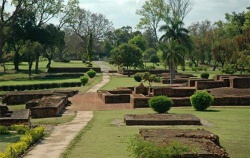Difference between revisions of "Sāvatthi"
Jump to navigation
Jump to search
m (Text replacement - "The Buddha" to "The Buddha") |
|||
| Line 1: | Line 1: | ||
[[File:Savatthi.jpg|thumb|250px|]] | [[File:Savatthi.jpg|thumb|250px|]] | ||
| − | [[Sāvatthi]] was the capital of the Kingdom of [[Kosala]], and according to [[tradition]], [[ | + | [[Sāvatthi]] was the capital of the Kingdom of [[Kosala]], and according to [[tradition]], The [[Buddha]] spent much of the last 23 years of his [[Life]] in the city. Today the ruins of [[Sāvatthi]] [[Form]] a large crescent about 5 kilometres long with the Rapti [[River]] running along its inner curve. A little to the south of the city are the ruins of the [[Jetavana]], a large [[monastic]] complex first established during The [[Buddha]]’s [[time]] and which continued to [[function]] for another 1500 years. Many locations in and around [[Sāvatthi]] are mentioned in the [[Tipiṭaka]] and a few of these can still be identified. |
‘[[Sravasti]] in Ancient [[India]]’, Memoirs of the Archaeological Survey of [[India]], 1935. | ‘[[Sravasti]] in Ancient [[India]]’, Memoirs of the Archaeological Survey of [[India]], 1935. | ||
Revision as of 17:04, 12 September 2013
Sāvatthi was the capital of the Kingdom of Kosala, and according to tradition, The Buddha spent much of the last 23 years of his Life in the city. Today the ruins of Sāvatthi Form a large crescent about 5 kilometres long with the Rapti River running along its inner curve. A little to the south of the city are the ruins of the Jetavana, a large monastic complex first established during The Buddha’s time and which continued to function for another 1500 years. Many locations in and around Sāvatthi are mentioned in the Tipiṭaka and a few of these can still be identified.
‘Sravasti in Ancient India’, Memoirs of the Archaeological Survey of India, 1935.
